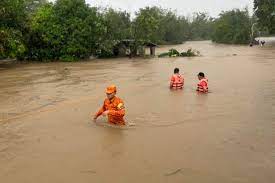Typhoon in Northern Philippines blows off roofs, floods villages, and uproots thousands of people
On Wednesday, when Typhoon Doksuri slammed onto a tiny island and pounded northern Philippine provinces with fierce winds and rain, it tore tin roofs off of houses, flooded low-lying towns, knocked out electricity, and forced more than 12,000 people from their homes, according to authorities.
There were around 12,100 people evacuated from high-risk coastal communities and schools, and businesses were closed as a precaution as Doksuri neared, but there were no early reports of injuries as the typhoon struck Fuga island off Aparri town in Cagayan province. The typhoon, which features a ring of wind and rain that is 700 kilometers wide (435 miles wide), has caused thousands of residents in other northern provinces to be relocated.
Despite a modest weakening, Doksuri continued to be deadly and hazardous, with sustained winds of 175 kph (109 mph) and gusts as high as 240 kph (149 mph). According to predictions, it was blowing across the coastal waters of Fuga and Aparri town on Wednesday morning.
“Our northern coastal towns are being battered,” Cagayan Governor Manuel Mamba told The Associated Press over the phone. I’m hearing accounts of water that couldn’t drain out and tin roofs being blown off, likely as a result of tidal surges pouring in from the sea.
After the typhoon passes, there will be an assessment of the damage, but Mamba expressed concern for the maize and rice plantations in the Cagayan valley, which had already been severely damaged by a months-long dry period before Doksuri made landfall.
According to a warning from the nation’s meteorological agency, “violent, life-threatening conditions are expected to continue” on Wednesday across northwest Cagayan, the distant Babuyan Islands, and the northern mountainous districts of Apayao and Ilocos Norte provinces.
In central and northern provinces, including the heavily populated metropolis of Manila, the typhoon has been boosting the seasonal monsoon rainfall. On Thursday, it was expected to leave the northern Philippines and head northwest toward Taiwan before making landfall in southeastern China later that day.
The Philippine coast guard said that more than 4,600 inter-island ferry passengers, freight truck drivers, approximately 100 passenger and cargo ships, and motor bancas were stuck in multiple ports where a no-sail order had been issued. A portion of the annual Han Kuang military drills in Taiwan were postponed on Tuesday.
As a result of its location on Taiwan’s southeast coast, where waves were already escalating, an exercise intended to replicate the usage of a civilian airport in the event that military runways were blown out was called off. According to Taiwan’s Central Weather Bureau, waves have already surged to as high as 2.5 meters (8 feet) in Taiwan’s southernmost point.
The greatest yearly exercises to show off Taiwan’s military’s defensive capabilities in the event of an invasion from China, which claims the self-ruled region as its own, are known as the Han Kuang exercises. In other regions of Taiwan, land-based training for the Han Kuang drills are still going on.







